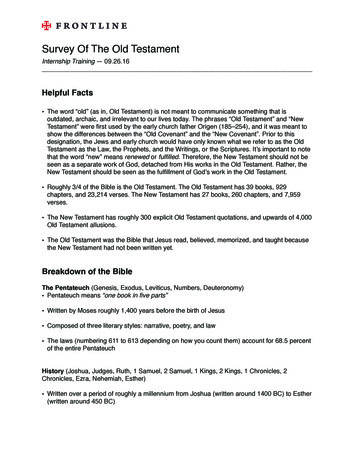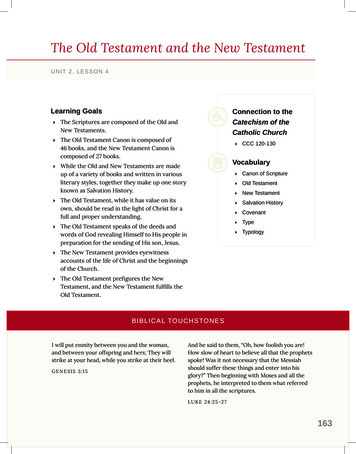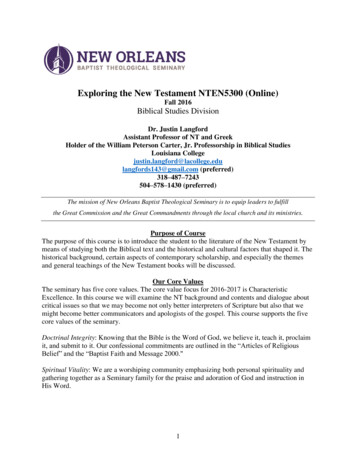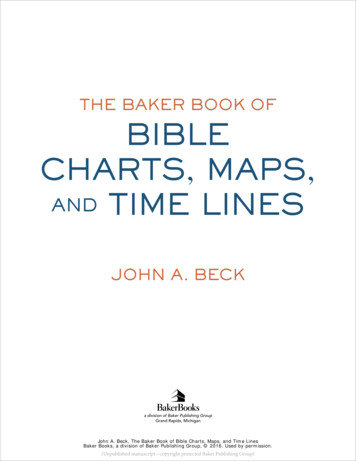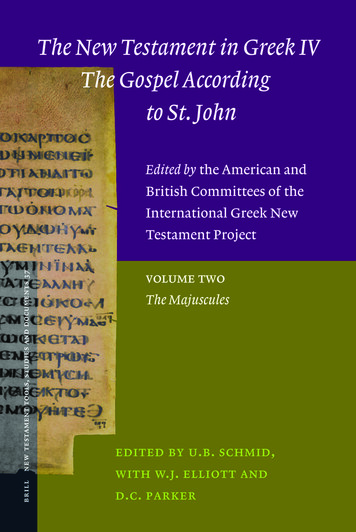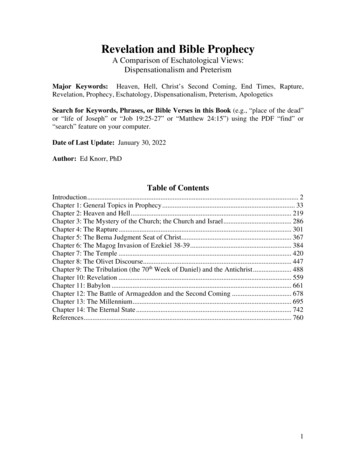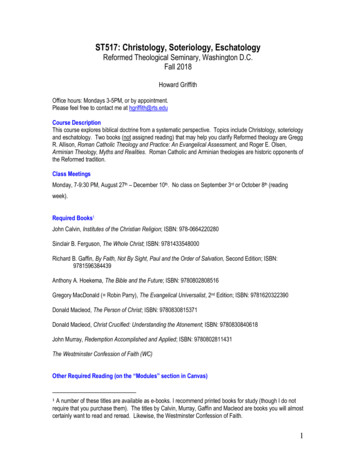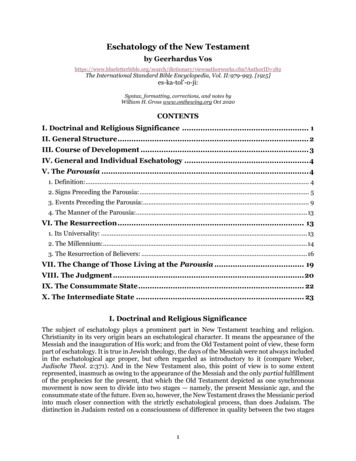
Transcription
Eschatology of the New Testamentby Geerhardus ry/viewauthorworks.cfm?AuthorID 182The International Standard Bible Encyclopedia, Vol. II:979-993. [1915]es-ka-tol’-o-ji:Syntax, formatting, corrections, and notes byWilliam H. Gross www.onthewing.org Oct 2020CONTENTSI. Doctrinal and Religious Significance . 1II. General Structure . 2III. Course of Development . 3IV. General and Individual Eschatology . 4V. The Parousia . 41. Definition: . 42. Signs Preceding the Parousia: . 53. Events Preceding the Parousia: . 94. The Manner of the Parousia: . 13VI. The Resurrection . 131. Its Universality: . 132. The Millennium:. 143. The Resurrection of Believers: . 16VII. The Change of Those Living at the Parousia . 19VIII. The Judgment . 20IX. The Consummate State . 22X. The Intermediate State . 23I. Doctrinal and Religious SignificanceThe subject of eschatology plays a prominent part in New Testament teaching and religion.Christianity in its very origin bears an eschatological character. It means the appearance of theMessiah and the inauguration of His work; and from the Old Testament point of view, these formpart of eschatology. It is true in Jewish theology, the days of the Messiah were not always includedin the eschatological age proper, but often regarded as introductory to it (compare Weber,Judische Theol. 2:371). And in the New Testament also, this point of view is to some extentrepresented, inasmuch as owing to the appearance of the Messiah and the only partial fulfillmentof the prophecies for the present, that which the Old Testament depicted as one synchronousmovement is now seen to divide into two stages — namely, the present Messianic age, and theconsummate state of the future. Even so, however, the New Testament draws the Messianic periodinto much closer connection with the strictly eschatological process, than does Judaism. Thedistinction in Judaism rested on a consciousness of difference in quality between the two stages1
— the content of the Messianic Age being far less spiritually and transcendentally conceived thanthat of the Final State. The New Testament, by spiritualizing the entire Messianic circle of ideas,becomes keenly alive to its affinity to the content of the highest eternal hope; and consequently ittends to identify the two, in order to find the age to come anticipated in the present. In some casesthis assumes an explicit shape in the belief that great eschatological transactions have alreadybegun to take place, and that believers have already attained to at least partial enjoyment ofeschatological privileges. Thus the present kingdom in our Lord’s teaching, is one in essence withthe final kingdom; according to the discourses in John, eternal life is in principle realized here;and with Paul, there has been a prelude to the Last Judgment and resurrection, in the death andresurrection of Christ, and the life in the Spirit is the first-fruits of the heavenly state to come.The strong sense of this may even express itself in the paradoxical form that the eschatologicalstate has arrived, and the one great incision in history has already been made (Heb 2:3, 5; 9:11;10:1; 12:22-24). Still, even where this extreme consciousness is reached, it nowhere supersedesthe other more common representation, according to which the present state continues to lie thisside of the eschatological crisis; and while directly leading up to the latter, it yet remains to allintents a part of the Old Age and world-order. Believers live in the “last days,” upon them “theends of the ages are come,” but “the Last Day,” “the consummation of the age,” still lies in thefuture (Mat 13:39, 40, 49; 24:3; 28:20; Joh 6:39, 44, 54; 12:48; 1Cor 10:11; 2Tim 3:1; Heb 1:2;9:26; Jas 5:3; 1Pet 1:5, 20; 2Pet 3:3; 1Joh 2:18; Jude 1:18).The eschatological interest of early believers was no mere fringe to their religious experience, butthe very heart of its inspiration. It expressed and embodied the profound supernaturalism andsoteriological character of the New Testament faith. The coming world was not to be the productof natural development, but of a Divine interposition arresting the process of history. And thedeepest motive of the longing for this world was a conviction of the abnormal character of thepresent world, a strong sense of sin and evil. This explains why the New Testament doctrine ofsalvation has grown up to a large extent in the closest interaction with its eschatological teaching.The present experience was interpreted in the light of the future. It is necessary to keep this inmind for a proper appreciation of the generally prevailing hope that the return of the Lord mightcome in the near future. Apocalyptic calculation had less to do with this, than the practicalexperience that the earnest of the supernatural realities of the life to come was present in thechurch; and that therefore it seemed unnatural for the full fruition of these to be long delayed.The subsequent receding of this acute eschatological state has something to do with the gradualdisappearance of the miraculous phenomena of the apostolic age.II. General StructureNew Testament eschatology attaches itself to the Old Testament and to Jewish belief as developedon the basis of ancient revelation. It creates on the whole no new system or new terminology, butincorporates much that was current; yet so as to reveal by selection and distribution of emphasisthe essential newness of its spirit. In Judaism there existed at that time two distinct types ofeschatological outlook. There was the ancient national hope which revolved around the destiny ofIsrael. Alongside of it existed a transcendental form of eschatology with a cosmical perspective,which had in view the destiny of the universe and of the human race. The former of theserepresents the original form of Old Testament eschatology; and therefore it occupies a legitimateplace in the beginnings of the New Testament development, notably in the revelationsaccompanying the birth of Christ and in the earlier (synoptical) preaching of John the Baptist.There entered into it, however (as held by the Jews), a considerable element of individual andcollective eudaemonism.1 And it had become identified with a literalistic interpretation ofprophecy, which did not sufficiently take into account the typical import and poetical characterof prophecy. The other scheme, while to some extent the product of subsequent theological1An ethical system that evaluates actions by reference to personal well-being through a life based on reason.2
development, lies prefigured in certain later prophecies, especially in Daniel; and far from beingan importation from Babylonian, or ultimately Persian sources (as some at present maintain),represents in reality the true development of the inner principles of Old Testament propheticrevelation. The structure of New Testament eschatology closely conforms itself to it.In doing this, however, it discards the impure motives and elements by which even this relativelyhigher type of Jewish eschatology was contaminated. In certain of the apocalyptic writings, acompromise is attempted between these two schemes in this manner: that the carrying out of theone is merely to follow that of the other — the national hope first receiving its fulfillment in aprovisional Messianic Kingdom of limited duration (400 or 1,000 years), to be superseded at theend by the Eternal State. The New Testament does not follow the Jewish theology along this path.Even though it regards the present work of Christ as preliminary to the consummate order ofthings, it does not separate the two in essence or quality; it does not exclude the Messiah from asupreme place in the coming world; and it does not expect a temporal Messianic kingdom in thefuture as distinguished from Christ’s present spiritual reign, and as preceding the state of eternity.In fact, the figure of the Messiah becomes central in the entire eschatological process, far more sothan is the case in Judaism. All the stages in this process — the resurrection, the judgment, thelife eternal, even the intermediate state — receive the impress of the absolute significance whichChristian faith ascribes to Jesus as the Christ. Through this Christocentric character, NewTestament eschatology also acquires far greater unity and simplicity than can be predicated bythe Jewish schemes. Everything is practically reduced to the great ideas of the resurrection andthe judgment, as consequent upon the Parousia of Christ. Much apocalyptic embroidery to whichno spiritual significance attached is eliminated. While the overheated fantasy tends to multiplyand elaborate, the religious interest tends toward concentration and simplification.III. Course of DevelopmentIn New Testament eschatological teaching, a general development in a well-defined direction istraceable. The starting-point is the historico-dramatic conception of the two successive ages.These two ages are distinguished as (1) houtos ho aion, ho nun aion, ho enesios aion, “this age,”“the present age” (Mat 12:32; 13:22; Luk 16:8; Rom 12:2; 1Cor 1:20; 2:6, 8; 3:18; 2Cor 4:4; Gal1:4; Eph 1:21; 2:2; 6:12; 1Tim 6:17; 2Tim 4:10; Tit 2:12), and (2) ho aion ekeinos, ho aion mellon,ho aion erchomenos, “that age,” “the future age” (Mat 12:32; Luk 18:30; 20:35; Eph 2:7; Heb6:5). In Jewish literature before the New Testament, no instances of the developed antithesisbetween these two ages seem to be found; but from the way in which it occurs in the teaching ofJesus and Paul, it appears to have been current at that time. (The oldest undisputed occurrence isa saying of Johanan ben Zaqqay, about 80 AD.) The contrast between these two ages is (especiallywith Paul) that between the evil & transitory, and the perfect & abiding. Thus, to each age belongsits own characteristic order of things; and so the distinction passes over into that of two “worlds”in the sense of two systems. In Hebrew and Aramaic, the same word ‘olam, ‘olam, does service forboth; in Greek, aion usually renders the meaning “age,” or occasionally “world” (Heb 1:2; 11:3) —kosmos meaning “world.” The latter, however, is never used of the future world. CompareDalman, Die Worte Jesu, 1:132-146. Broadly speaking, the development of New Testamenteschatology consists in this: that the two ages are increasingly recognized as answering to twospheres of being which coexist from of old; so that the coming of the New Age assumes thecharacter of a revelation and extension of the supernal order of things, rather than that of its firstentrance into existence. Inasmuch as the coming world stood for the perfect and eternal — and inthe realm of heaven, such a perfect, eternal order of things already existed — the reflectioninevitably arose that these two were in some sense identical. But the new significance which theantithesis assumes, does not supersede the older historico-dramatic form. The higher world sointerposes in the course of the lower, as to bring the conflict to a crisis.3
The passing over of the one contrast into the other, therefore, does not mark (as has frequentlybeen asserted) a recession of the eschatological wave, as if the interest had been shifted from thefuture to the present life. Especially in the Fourth Gospel, this “de-eschatologizing” process hasbeen found, but without real warrant. The apparent basis for such a conclusion is that the realitiesof the future life are so vividly and intensely felt to be existent in heaven, and from there operativein the believer’s life, that the distinction between what is now and what will hereafter be enjoyed,becomes less sharp. Instead of the supersedure of the eschatological, this means the very opposite;namely, its most real anticipation. It should further be observed that the development in questionis intimately connected and keeps equal pace with the disclosure of the preexistence of Christ —because this fact, and the descent of Christ from heaven, furnished the clearest witness to thereality of the heavenly order of things. Hence, it is especially observable, not in the earlier epistlesof Paul, where the structure of eschatological thought is still in the main historico-dramatic, butin the epistles of the first captivity (Eph 1:3, 10-22; 2:6; 3:9, 10; 4:9, 10; 6:12; Phi 2:5-11; 3:20; Col1:15, 17; 3:2; further, in Heb 1:2, 3; 2:5; 3:4; 6:5, 11; 7:13, 16; 9:14; 11:10, 16; 12:22, 23). The FourthGospel marks the culmination of this line of teaching; and it is unnecessary to point out how herethe contrast between heaven and earth in its Christological consequences determines the entirestructure of thought. But here it also appears how the last outcome of the New Testament progressof doctrine had been anticipated in the highest teaching of our Lord. This can be accounted for bythe inherent fitness that the supreme disclosures which touch the personal life of the Saviorshould come not through any third person, but from His own lips.IV. General and Individual EschatologyIn the Old Testament, the destiny of the nation of Israel to such an extent overshadows that of theindividual, that only the first rudiments of an individual eschatology are found. The individualismof the later prophets, especially Jeremiah and Ezekiel, bore fruit in the thought of the intermediateperiod. In the apocalyptic writings, considerable concern is shown for the ultimate destiny of theindividual. But not until the New Testament thoroughly spiritualized the conceptions of the lastthings could these two aspects be perfectly harmonized. Through the centering of theeschatological hope in the Messiah, and the suspending of the individual’s share in it on hispersonal relation to the Messiah, an individual significance is necessarily imparted to the greatfinal crisis. This also tends to give greater prominence to the intermediate state. Here, also,apocalyptic thought had pointed the way. Nonetheless, the Old Testament point of view continuesto assert itself in that even in the New Testament, the main interest still attaches to the collective,historical development of events. Many questions in regard to the intermediate period are passedby in silence. The Old Testament prophetic foreshortening of the perspective, immediatelyconnecting each present crisis with the ultimate goal, is reproduced in New Testamenteschatology on an individual scale in so far as the believer’s life here is linked, not so much withhis state after death, but rather with the consummate state after the final judgment. The presentlife in the body, and the future life in the body, are the two outstanding illumined heights betweenwhich the disembodied state remains largely in the shadow. But the same foreshortening of theperspective is also carried over from the Old Testament into the New Testament delineation ofgeneral eschatology. The New Testament method of depicting the future is not chronological.Things lying widely apart to our chronologically-informed experience, are by it drawn closelytogether. Doubtless this law is adhered to, not from mere limitation of subjective humanknowledge, but by reason of adjustment to the general method of prophetic revelation in the Oldand New Testaments alike.V. The Parousia1. Definition:The word denotes “coming,” “arrival.” It is never applied to the Incarnation of Christ, and couldbe applied to His second coming only; this is partly because it had already become a fixed4
Messianic term, and partly because there was a point of view from which the future appearanceof Jesus appeared to be the sole adequate expression of His Messianic dignity and glory. Theexplicit distinction between “first advent” and “second advent” is not found in the New Testament.It occurs in Testament of the Twelve Patriarchs, Testament of Abraham 92:16. In the NewTestament, it is approached in Heb 9:28 and in the use of epiphaneia for both the past appearanceof Christ, and His future manifestation (2The 2:8; 1Tim 6:14; 2Tim 1:10; 4:1; Tit 2:11, 13). TheChristian use of the word Parousia is more or less colored by the consciousness of the presentbodily absence of Jesus from His own, and consequently it suggests the thought of His futureabiding presence, without formally coming to mean the state of the Savior’s presence withbelievers (1The 4:17). Parousia occurs in Mat 24:3, 17, 39; 1Cor 15:23; 1The 2:19; 3:13; 4:15; 5:23;2The 2:1, 8; Jas 5:7, 8; 2Pet 1:16; 3:4, 12; 1Joh 2:28. A synonymous term is apokalupsis,“revelation,” probably also of pre-Christian origin, presupposing the pre-existence of the Messiahin hidden form previous to His manifestation, either in heaven or on earth (compare ApocryphaBaruch 3:29; 1:20; 4Ezra; 2Esdras 7:28; Testament of the Twelve Patriarchs, Testament of Levi18; Joh 7:27; 1Pet 1:20). It could be adopted by Christians because Christ had been withdrawninto heaven, and He would be publicly demonstrated to be the Christ on His return; hence it isused with special reference to enemies and unbelievers (Luk 17:30; Act 3:21; 1Cor 16; 2The 1:7, 8;1Pet 1:13, 20; 5:4). Another synonymous term is “the day of the (Our) Lord,” “the day,” “that day,”“the day of Jesus Christ.” This is the rendering of the well-known Old Testament phrase. Thoughthere is no reason in any particular passage why “the Lord” should not be Christ, the possibilityexists that in some cases it may refer to God (compare “day of God” in 2Pet 3:12). On the otherhand, what the Old Testament predicates of God with the use of this phrase, is sometimespurposely transferred to Christ in the New Testament. “Day,” while employed of the Parousiagenerally, is (as in the Old Testament) mostly associated with the Judgment, so as to become asynonym for judgment (compare Act 19:38; 1Cor 4:3). The phrase is found in Mat 7:22; 24:36;Mar 13:32; Luk 10:12; 17:24; 21:34; Act 2:20; Rom 13:12; 1Cor 1:8; 3:13; 5:5; 2Cor 1:14; Phi 1:6;2:16; 1The 5:2, 4 (compare 5:5, 8); 2The 2:2; 2Tim 1:12, 18; 4:8; Heb 10:25; 2Pet 3:10.2. Signs Preceding the Parousia:The Parousia is preceded by certain signs heralding its approach. Judaism, on the basis of the OldTestament, had worked out the doctrine of “the woes of the Messiah,” chebhele ha-mashiach, thecalamities and afflictions attendant upon the close of the present and the beginning of the comingage, being interpreted as birth pains of the latter. This is transferred in the New Testament to theParousia of Christ. The phrase occurs only in Mat 24:8; Mar 13:8; the idea occurs in Rom 8:22;and allusions to it occur probably in 1Cor 7:26; 1The 3:3; 5:3. Besides these general “woes” (andalso in accord with Jewish doctrine), the appearance of the Antichrist is made to precede the finalcrisis. Without Jewish precedent, the New Testament links with the Parousia as preparatory to it,the pouring out of the Spirit, the destruction of Jerusalem and the temple, the conversion of Israel,and the preaching of the gospel to all the nations. The problem of the sequence and interrelationof these several precursors of the end ,is a most difficult and complicated one; and at the present,it would seem not ripe for solution. The “woes” which are mentioned in our Lord’s eschatologicaldiscourse (Mat 24; Mark 13; Luke 21), in more or less close accord with Jewish teaching, are these:(1) wars, earthquakes and famines, “the beginning of travail;”(2) the great tribulation;(3) commotions among the heavenly bodies; compare Rev 6:2-17.For Jewish parallels to these, compare Charles, Eschatology, 326, 327. Because of this elementwhich the discourse has in common with Jewish apocalypses, it has been assumed by Colani,Weiffenbach, Weizsacker, Wendt, et al., that here two sources have been welded together: (1) anactual prophecy of Jesus, and (2) a Jewish or Jewish-Christian apocalypse from the time of theJewish War 68-70 (Historia Ecclesiastica, 3.5.3). In the text of Mark, this so-called “small5
apocalypse” is believed to consist of Mar 13:7, 8, 14-20, 24-27, 30, 31. But this hypothesis mainlysprings from the disinclination to ascribe to Jesus, realistic eschatological expectations, and theentirely unwarranted assumption that He must have spoken of the end in purely ethical andreligious terms only. That the typically Jewish “woes” bear no direct relation to the disciples andtheir faith, is not a sufficient reason for declaring the prediction of them unworthy of Jesus. Acontradiction is pointed out between the two representations, that the Parousia will comesuddenly, unexpectedly, and that it will come heralded by these signs. Especially in Mar 13:30, 32the contradiction is said to be pointed. To this it may be replied that even after the removal of theassumed apocalypse, the same twofold representation remains present in what is recognized asgenuine discourse of Jesus, namely, in Mar 13:28, 29 as compared with 13:32, 33-37 and othersimilar admonitions to watchfulness. A real contradiction between 13:30 and 13:32 does not exist.Our Lord could consistently affirm both:“This generation shall not pass away, until all these things be accomplished,” and “of that day orhour no one knows.” To be sure, the solution should not be sought by understanding “thisgeneration” to mean the Jewish race or the human race. It must mean, according to ordinaryusage, the then living generation. Nor does it help matters to distinguish between the predictionof the Parousia within certain wide limits, and the denial of knowledge as to the precise day andhour. In point of fact, the two statements do not refer to the same matter at all. “That day or thathour” in 13:32 does not have “these things” of 13:30 for its antecedent. Both by the demonstrativepronoun “that,” and by “but,” it is marked as an absolute self-explanatory conception. It simplysignifies as elsewhere, the Day of the Lord, the Day of Judgment. Of “these things,” the exactmeaning of which phrase must be determined from the foregoing, Jesus declares that they willcome to pass within that generation; but concerning the Parousia, “that (great) day,” He declaresthat no one but God knows the time of its occurrence. The correctness of this view is confirmedby the preceding parable, Mar 13:28, 29, where in precisely the same way “these things” and theParousia are distinguished. The question remains how much “these things” (verse 29; Luk 21:31),“all these things” (Mat 24:33, 24; Mar 13:30), “all things” (Luk 21:32) is intended to cover what isdescribed in the preceding discourse. The answer will depend on what is represented there asbelonging to the precursors of the end, and what as strictly constituting part of the end itself —and on the other question, whether Jesus predicts one end with its premonitory signs, or refers totwo crises, each of which will be heralded by its own series of signs. Here two views deserveconsideration. According to the one (advocated by Zahn in his Commentary on Matthew, 65266) the signs cover only Mat 24:4-14.What is related afterward — namely, “the abomination of desolation,” great tribulation, falseprophets and Christs, commotions in the heavens, the sign of the Son of Man — all this belongsto “the end” itself, in the absolute sense, and is therefore comprehended in the Parousia, and it isexcepted from the prediction that it will happen in that generation; while it is included in thedeclaration that only God knows the time of its coming. The destruction of the temple and theholy city, though not explicitly mentioned in Mat 24:4-14, would be included in what is said thereabout wars and tribulation. The prediction thus interpreted would have been literally fulfilled.The objections to this view are:(1) It is unnatural to thus subsume what is related in 24:15-29 under “the end.” From a formalpoint of view it does not differ from the phenomena of 24:4-14 which are “signs.”(2) It creates the difficulty that the existence of the temple and the temple-worship in Jerusalemare presupposed in the last days, immediately before the Parousia.The “abomination of desolation” taken from Daniel 8:13; 9:27; 11:31; 12:11; compare Sirach 49:2— according to some, the destruction of the city and temple, better a desecration of the templesite by the setting up of something idolatrous, as a result of which it becomes desolate — andthe flight from Judea, are put among events which, together with the Parousia, constitute the6
end of the world. This would seem to involve Chiliasm 1 of a very pronounced sort. The difficultyrecurs in the strictly eschatological interpretation of 2The 2:3, 1, where “the man of sin” (seeMan of Sin:) is represented as sitting in “the temple of God;” and in Rev 11:1, 2, where “thetemple of God” and “the altar,” and “the court which is without the temple,” and “the holy city,”figure in an episode inserted between the sounding of the trumpet of the sixth angel, and thatof the seventh. On the other hand, it ought to be remembered that eschatological prophecymakes use of ancient traditional imagery and stereotyped formulas which, precisely becausethey are fixed and applied to all situations, cannot always bear a literal sense, but must besubject to a certain degree of symbolical and spiritualizing interpretation. In the present case,the profanation of the temple by Antiochus Epiphanes may have furnished the imagery in which,by Jesus, Paul, and John, anti-Christian developments are described of a nature which hasnothing to do with Israel, Jerusalem, or the temple, literally understood.(3) It is not easy to conceive of the preaching of the gospel to all the nations as falling within thelifetime of that generation. It is true, Rom 1:13; 10:18; 15:19-24; Col 1:6; 1Tim 3:16; 2Tim 4:17might be quoted in support of such a view. In the statement of Jesus, however, it is definitelypredicted that the preaching of the gospel to all the nations not only must happen before theend, but that it straightway precedes the end:“Then shall the end come” (Mat 24:14). To distinguish between the preaching of the gospel toall the nations, and the completion of the Gentile mission, as Zahn proposes, is artificial. As overagainst these objections, however, it must be admitted that grouping all these later phenomenabefore the end proper, avoids the difficulty arising from “immediately” in Mat 24:29, and from“in those days” in Mar 13:24.The other view has been most lucidly set forth by Briggs, Messiah of the Gospels, 132-165. It makesJesus’ discourse relate to two things:(1) the destruction of Jerusalem and the temple;(2) the end of the world.He further assumes that the disciples are informed with respect to two points:(1) the time;(2) the signs.In the answer to the time, however, the two things are not sharply distinguished, but united intoone prophetic perspective, the Parousia standing out more conspicuously. The definition of thetime of this complex development is, (a) negative (Mar 13:5-8); (b) positive (Mar 13:9-13).On the other hand, in describing the signs, Jesus discriminates between (a) the signs of thedestruction of Jerusalem and the temple (Mar 13:14-20); and (b) the signs of the Parousia (Mar13:24-27). This view has in its favor that the destruction of the temple and the city, which in thequestion of the disciples figured as an eschatological event, is recognized as such in the answer ofJesus, and it is not alluded to in a mere incidental fashion, as being among the signs. Especiallythe version in Luk 21:20-24 proves that it figures as an event. This view also renders easier therestriction of Mar 13:30 to the first event and its signs. It places “the abomination of desolation”in the period preceding the national catastrophe. The view that the two events are successivelydiscussed is further favored by the movement of thought in Mar 13:32. Here, after the Apocalypsehas been brought to a close, the application to the disciples is made in the same order as observedin the prophecy: first, the true attitude toward the national crisis is defined in the parable of theChiliasm: also called the Jewish Dream or Golden Age; belief that the physical nation of Israel will be restored priorto the Judgment, and will reign over the nations of the earth for 1000 years. Adopted by Dispensationalists. – WHG17
Fig Tree, and in the solemn assurance appended that it will happen in this generation (13:28-31);and secondly, the true attitude toward the Parousia is defined (13:32-37).The only serious objection that may be urged against this view, arises from the close concatenationof the section relating to the national crisis, with the section relating to the
New Testament eschatology attaches itself to the Old Testament and to Jewish belief as developed on the basis of ancient revelation. It creates on the whole no new system or new terminology, but incorporates much that was current; yet so as to reveal by selection and dist

